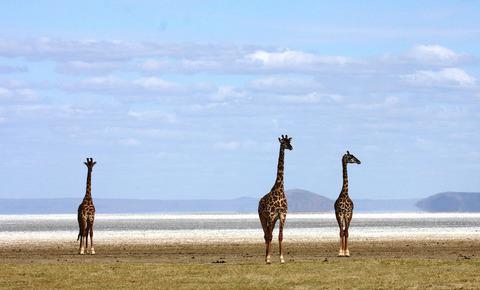当前位置:
X-MOL 学术
›
J. Anim. Ecol.
›
论文详情
Our official English website, www.x-mol.net, welcomes your
feedback! (Note: you will need to create a separate account there.)
Proximity to humans affects local social structure in a giraffe metapopulation
Journal of Animal Ecology ( IF 3.5 ) Pub Date : 2020-06-08 , DOI: 10.1111/1365-2656.13247 Monica L Bond 1, 2 , Barbara König 1 , Derek E Lee 2, 3 , Arpat Ozgul 1 , Damien R Farine 4, 5, 6
Journal of Animal Ecology ( IF 3.5 ) Pub Date : 2020-06-08 , DOI: 10.1111/1365-2656.13247 Monica L Bond 1, 2 , Barbara König 1 , Derek E Lee 2, 3 , Arpat Ozgul 1 , Damien R Farine 4, 5, 6
Affiliation

|
Experimental laboratory evidence suggests that animals with disrupted social systems express weakened relationship strengths and have more exclusive social associations, and that these changes have functional consequences. A key question is whether anthropogenic pressures have a similar impact on the social structure of wild animal communities. We addressed this question by constructing a social network from 6 years of systematically collected photographic capture-recapture data spanning 1,139 individual adult female Masai giraffes inhabiting a large, unfenced, heterogeneous landscape in northern Tanzania. We then used the social network to identify distinct social communities, and tested whether social or anthropogenic and other environmental factors predicted differences in social structure among these communities. We reveal that giraffes have a multilevel social structure. Local preferences in associations among individuals scale up to a number of distinct, but spatially overlapping, social communities, that can be viewed as a large interconnected metapopulation. We then find that communities that are closer to traditional compounds of Indigenous Masai people express weaker relationship strengths and the giraffes in these communities are more exclusive in their associations. The patterns we characterize in response to proximity to humans reflect the predictions of disrupted social systems. Near bomas, fuelwood cutting can reduce food resources, and groups of giraffes are more likely to encounter livestock and humans on foot, thus disrupting the social associations among group members. Our results suggest that human presence could potentially be playing an important role in determining the conservation future of this megaherbivore.
中文翻译:

与人类的接近影响长颈鹿集合种群的当地社会结构
实验实验室证据表明,社会系统受到破坏的动物表现出的关系强度减弱,并且具有更多的排他性社会联系,并且这些变化具有功能性后果。一个关键问题是人为压力是否对野生动物群落的社会结构有类似的影响。我们通过 6 年系统收集的摄影捕获-再捕获数据构建了一个社交网络来解决这个问题,这些数据涵盖了 1,139 只成年雌性马赛长颈鹿,它们栖息在坦桑尼亚北部一个大型、无围栏的异质景观中。然后我们使用社交网络来识别不同的社会社区,并测试社会或人为和其他环境因素是否预测了这些社区之间社会结构的差异。我们揭示了长颈鹿具有多层次的社会结构。个体之间关联的局部偏好可扩展到许多不同但在空间上重叠的社会社区,这些社区可以被视为一个大型的相互关联的元种群。然后我们发现,更接近土著马赛人传统聚居地的社区表现出较弱的关系优势,并且这些社区中的长颈鹿在他们的协会中更加排斥。我们在与人类接近时所表征的模式反映了对破坏的社会系统的预测。在博马斯附近,薪柴砍伐会减少食物资源,而长颈鹿群更容易遇到步行的牲畜和人类,从而破坏群成员之间的社会交往。
更新日期:2020-06-08
中文翻译:

与人类的接近影响长颈鹿集合种群的当地社会结构
实验实验室证据表明,社会系统受到破坏的动物表现出的关系强度减弱,并且具有更多的排他性社会联系,并且这些变化具有功能性后果。一个关键问题是人为压力是否对野生动物群落的社会结构有类似的影响。我们通过 6 年系统收集的摄影捕获-再捕获数据构建了一个社交网络来解决这个问题,这些数据涵盖了 1,139 只成年雌性马赛长颈鹿,它们栖息在坦桑尼亚北部一个大型、无围栏的异质景观中。然后我们使用社交网络来识别不同的社会社区,并测试社会或人为和其他环境因素是否预测了这些社区之间社会结构的差异。我们揭示了长颈鹿具有多层次的社会结构。个体之间关联的局部偏好可扩展到许多不同但在空间上重叠的社会社区,这些社区可以被视为一个大型的相互关联的元种群。然后我们发现,更接近土著马赛人传统聚居地的社区表现出较弱的关系优势,并且这些社区中的长颈鹿在他们的协会中更加排斥。我们在与人类接近时所表征的模式反映了对破坏的社会系统的预测。在博马斯附近,薪柴砍伐会减少食物资源,而长颈鹿群更容易遇到步行的牲畜和人类,从而破坏群成员之间的社会交往。











































 京公网安备 11010802027423号
京公网安备 11010802027423号